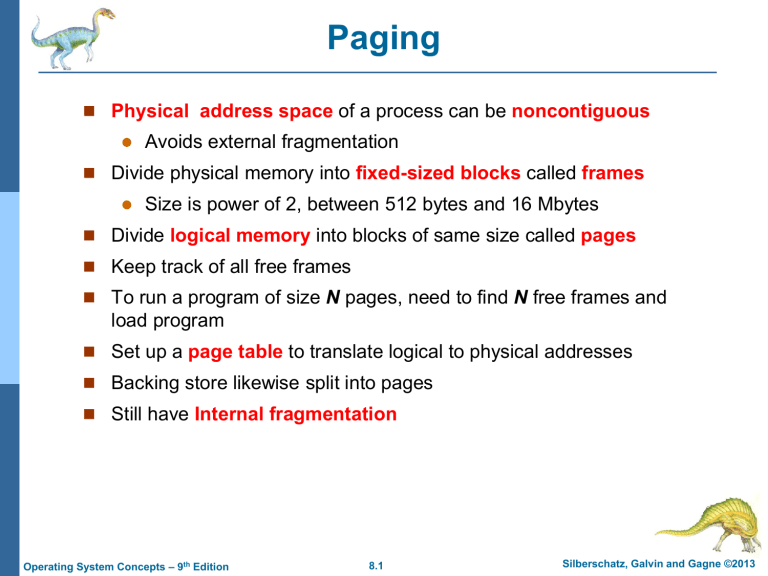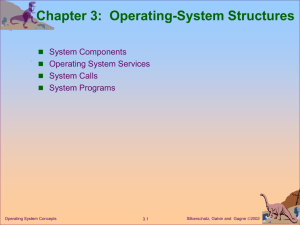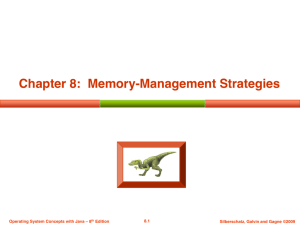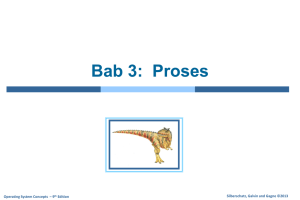part2
advertisement

Paging Physical address space of a process can be noncontiguous Avoids external fragmentation Divide physical memory into fixed-sized blocks called frames Size is power of 2, between 512 bytes and 16 Mbytes Divide logical memory into blocks of same size called pages Keep track of all free frames To run a program of size N pages, need to find N free frames and load program Set up a page table to translate logical to physical addresses Backing store likewise split into pages Still have Internal fragmentation Operating System Concepts – 9th Edition 8.1 Silberschatz, Galvin and Gagne ©2013 Address Translation Scheme Address generated by CPU is divided into: Page number (p) – used as an index into a page table which contains base address of each page in physical memory Page offset (d) – combined with base address to define the physical memory address that is sent to the memory unit page number page offset p d m -n n For given logical address space 2m and page size 2n Operating System Concepts – 9th Edition 8.2 Silberschatz, Galvin and Gagne ©2013 Paging Hardware Operating System Concepts – 9th Edition 8.3 Silberschatz, Galvin and Gagne ©2013 Paging Model of Logical and Physical Memory Operating System Concepts – 9th Edition 8.4 Silberschatz, Galvin and Gagne ©2013 Paging Example n=2 and m=4 32-byte memory and 4-byte pages Operating System Concepts – 9th Edition 8.5 Silberschatz, Galvin and Gagne ©2013 Paging (Cont.) Calculating internal fragmentation Page size = 2,048 bytes Process size = 72,766 bytes 35 pages + 1,086 bytes Internal fragmentation of 2,048 - 1,086 = 962 bytes Worst case fragmentation = 1 frame – 1 byte On average fragmentation = 1 / 2 frame size So small frame sizes desirable? But each page table entry takes memory to track Operating System Concepts – 9th Edition 8.6 Silberschatz, Galvin and Gagne ©2013 Free Frames Before allocation Operating System Concepts – 9th Edition After allocation 8.7 Silberschatz, Galvin and Gagne ©2013 Implementation of Page Table Page table is kept in main memory Page-table base register (PTBR) points to the page table Page-table length register (PTLR) indicates size of the page table In this scheme every data/instruction access requires two memory accesses One for the page table One for the data / instruction The two memory access problem can be solved by the use of a special fast-lookup hardware cache called translation look-aside buffers (TLBs) Operating System Concepts – 9th Edition 8.8 Silberschatz, Galvin and Gagne ©2013 Implementation of Page Table (Cont.) Some TLBs store address-space identifiers (ASIDs) in each TLB entry – uniquely identifies each process to provide address-space protection for that process Otherwise need to flush at every context switch TLBs typically small (64 to 1,024 entries) On a TLB miss, value is loaded into the TLB for faster access next time Replacement policies must be considered Operating System Concepts – 9th Edition 8.9 Silberschatz, Galvin and Gagne ©2013 Paging Hardware With TLB Operating System Concepts – 9th Edition 8.10 Silberschatz, Galvin and Gagne ©2013 Memory Protection Memory protection implemented by associating protection bit with each frame to indicate if read-only or read-write access is allowed Can also add more bits to indicate page execute-only, and so on Valid-invalid bit attached to each entry in the page table: “valid” indicates that the associated page is in the process’ logical address space, and is thus a legal page “invalid” indicates that the page is not in the process’ logical address space Or use page-table length register (PTLR) Any violations result in a trap to the kernel Operating System Concepts – 9th Edition 8.11 Silberschatz, Galvin and Gagne ©2013 Valid (v) or Invalid (i) Bit In A Page Table Operating System Concepts – 9th Edition 8.12 Silberschatz, Galvin and Gagne ©2013 Shared Pages Shared code One copy of read-only (reentrant) code shared among processes (i.e., text editors, compilers, window systems) Similar to multiple threads sharing the same process space Also useful for inter process communication (IPC) if sharing of read-write pages is allowed Operating System Concepts – 9th Edition 8.13 Silberschatz, Galvin and Gagne ©2013 Shared Pages Example Operating System Concepts – 9th Edition 8.14 Silberschatz, Galvin and Gagne ©2013 Structure of the Page Table Page tables can get huge using straight-forward methods Consider a 32-bit logical address space as on modern computers Page size of 4 KB (212) Page table would have 1 million entries (232 / 212) If each entry is 4 bytes -> 4 MB of physical address space / memory for page table alone That amount of memory used to cost a lot Don’t want to allocate that contiguously in main memory Solutions: Hierarchical Paging Hashed Page Tables Inverted Page Tables Operating System Concepts – 9th Edition 8.15 Silberschatz, Galvin and Gagne ©2013 Hierarchical Page Tables Break up the logical address space into multiple page tables A simple technique is a two-level page table We then page the page table Operating System Concepts – 9th Edition 8.16 Silberschatz, Galvin and Gagne ©2013 Two-Level Page-Table Scheme Operating System Concepts – 9th Edition 8.17 Silberschatz, Galvin and Gagne ©2013 Two-Level Paging Example A logical address (on 32-bit machine with 1K page size) is divided into: a page number consisting of 22 bits a page offset consisting of 10 bits Since the page table is paged, the page number is further divided into: a 12-bit page number a 10-bit page offset Thus, a logical address is as follows: where p1 is an index into the outer page table, and p2 is the displacement within the page of the inner page table Known as forward-mapped page table Operating System Concepts – 9th Edition 8.18 Silberschatz, Galvin and Gagne ©2013 Address-Translation Scheme Operating System Concepts – 9th Edition 8.19 Silberschatz, Galvin and Gagne ©2013 64-bit Logical Address Space Even two-level paging scheme not sufficient If page size is 4 KB (212) Then page table has 252 entries If two level scheme, inner page tables could be 210 4-byte entries Address would look like Outer page table has 242 entries or 244 bytes One solution is to add a 2nd outer page table But in the following example the 2nd outer page table is still 234 bytes in size And possibly 4 memory accesses to get to one physical memory location Operating System Concepts – 9th Edition 8.20 Silberschatz, Galvin and Gagne ©2013 Three-level Paging Scheme Operating System Concepts – 9th Edition 8.21 Silberschatz, Galvin and Gagne ©2013 Hashed Page Tables Common in address spaces > 32 bits The virtual page number is hashed into a page table Each element contains 1. the virtual page number 2. the value of the mapped page frame 3. a pointer to the next element Virtual page numbers are compared in this chain searching for a match If a match is found, the corresponding physical frame is extracted Operating System Concepts – 9th Edition 8.22 Silberschatz, Galvin and Gagne ©2013 Hashed Page Table Operating System Concepts – 9th Edition 8.23 Silberschatz, Galvin and Gagne ©2013 Inverted Page Table Rather than each process having a page table and keeping track of all possible logical pages, track all physical pages One entry for each real page of memory Entry consists of the virtual address of the page stored in that real memory location, with information about the process that owns that page Decreases memory needed to store each page table, but increases time needed to search the table when a page reference occurs Use hash table to limit the search to one — or at most a few — page-table entries TLB can accelerate access But how to implement shared memory? One mapping of a virtual address to the shared physical address Operating System Concepts – 9th Edition 8.24 Silberschatz, Galvin and Gagne ©2013 Inverted Page Table Architecture Operating System Concepts – 9th Edition 8.25 Silberschatz, Galvin and Gagne ©2013











